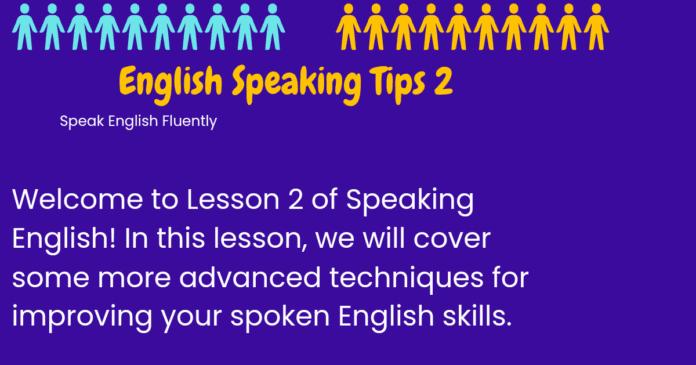Welcome to the next lesson of Speaking English! In this lesson, we will cover some tips for English speaking confidently.
Tips for English Speaking
Believe in Yourself: The first step to speaking confidently in English is to believe in yourself. Don’t be afraid to make mistakes, and remind yourself that you can do it!
Prepare: If you are nervous about speaking in English, prepare ahead of time. Practice what you want to say and think about possible questions or responses.
Start with Small Talk: Starting with small talk can help you build your confidence when speaking in English. Try starting a conversation with a simple greeting, such as “Hello, how are you?”
Use Body Language: Body language can help you communicate your message more effectively. Use gestures and facial expressions to emphasize your points and show confidence.
Speak Slowly and Clearly: Speaking slowly and clearly can help you communicate your message more effectively and reduce your nervousness. Pay attention to your pronunciation and try to speak clearly and distinctly.
Use Positive Language: Use positive language when speaking in English. This can help you sound more confident and positive. Instead of saying “I can’t do it,” say “I’ll try my best.”
Remember, confidence comes with practice. Use these tips to build your confidence when speaking in English and keep practicing. In the next lesson, we will cover some tips for improving your listening skills in English.
Welcome to the next lesson of Speaking English! In this lesson, we will cover some tips for improving your listening skills in English.
Listen to Native Speakers: One of the best ways to improve your listening skills in English is to listen to native English speakers. You can watch movies or TV shows in English, listen to podcasts, or attend English-speaking events.
Focus on Understanding the Main Idea: When listening to English, focus on understanding the main idea rather than trying to catch every single word. This will help you develop your listening skills and make it easier to understand conversations.
Practice Active Listening: Active listening involves paying attention to the speaker and engaging in the conversation. To practice active listening, ask questions, repeat what the speaker has said, and summarize what you have heard.
Improve Your Vocabulary: Expanding your vocabulary can help you understand more of what you hear. Learn new words and try to use them in your conversations.
Use Subtitles or Transcripts: Using subtitles or transcripts can help you understand spoken English better. This can be especially helpful when watching movies or TV shows in English.
Practice, Practice, Practice: Like any skill, listening takes practice. Practice listening to English every day, even if it’s just for a few minutes. Use language learning apps or listen to English music to make it a fun and regular part of your routine.
Remember, improving your listening skills in English takes time and practice. Use these tips for English speaking to help you become a better listener and keep working on improving your skills. In the next lesson, we will cover some tips for improving your reading skills in English. Along with these tips for English speaking , keep reading and listening English.









